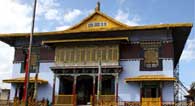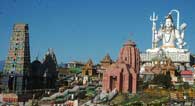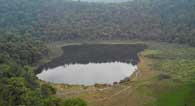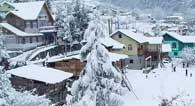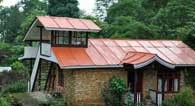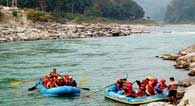Darjeeling
Darjeeling situated in the north eastern region in India provides the perfect ambience of a hill resort with its mild climate
conditions and its laid back charms. Its verdant hills and valleys are steeped in colour and are interspersed with vast stretches
of lush green tea gardens. Presiding over all these is the Mount Kanchenjunga (Mount Khangchendzonga) with the commanding height
of 8,586 meters which looms over the northern horizon, giving a magical aura to the land that entices thousands to its environs
and leaves all the senses intoxicated.
Darjeeling also known as the Queen of the Hills with its rich natural reserves of Pines and Rhododendrons is bounded by Sikkim
State in the north, Nepal in the west, Bhutan in the east and Siliguri on the south.
Nestled under the grandeur and beauty of towering snow capped mountain Mount Khangchendzonga lies the town. Word "Darjeeling"
as derived from Tibetan Language means (Dorji – thunder bolt and Ling – place): Land of Thunder Bolt. The town itself as laid out
by Lord Napier of Royal Engineers is at an altitude of 2134 metres. Heavily influenced by British India it still carries
imprints reminiscent of its colonial past.
As one moves above through Kurseong towards Darjeeling, one is greeted by smiling tea gardens, changing to firs, pines and fast
moving torrents, while around abound 4000 types of flowering plants and nearly 300 varieties of ferns, including the rare tree fern.
Town which is located on a spur with houses hugging the hillside has attractive shops, houses and handsome villas and churches and
heritage buildings reflecting Victorian architectures along with charming cafes and other interesting places that attract visitors.
Town which is built like series of landings joint by flights of steps and almost vertical planes can be divided into two categories
where upper side are mainly hangouts for tourists and visitors while the lower side with the vibrant colours are the spread of
market place where the essential commodities can be purchased for day to day life. In the market square are sold the vegetables,
fruits, butter, cheese, tea, brassware, curious, rugs, floorings, clothing, turquoise and jewelleries along with rations etc.
The Capital Hall at the heart of town which at present in-house the Municipality Office has the Clock Tower reflecting the beauty
and at one time the Summer Capital of British India. As the spread of land from town goes down to the Rangeet River at the North
bordering Sikkim, terai area past Kurseong Sub–Division at the south touching Siliguri, while scaling up to the Nepal at west and
Bhutan at East across river Teesta through Kalimpong Sub–Division, Darjeeling District has wider range of flora and fauna in the
form of natural capital and wealth of rich biodiversity reserves. Geographically, the place can be divided from tropical regions in
terai area to alpine regions at Sandakphu area bordering Nepal at the west which offers the high altitude treks filled with the
spirit of adventure to marvel the beauty and splendour. Foothill forest at terai area to alpine area there exist wild animals ranging
from Red–Panda, Hog–Badger, Crestless Porcupine, Goral, Serow, Musk Deer, Bear, Leopard, Snakes, Rabbits etc. The forest is shared by
large species of birds where some are migratory along with many species of butterflies. Tropical vegetation consisting of densely
grown trees of Sal (Shorea Robusta), Segum (Tectona Grandes) etc, spreads up to temperate and alpine regions with the trees like
Maple, Silver Fir, Juniper, Willow, Hemlock, Pines, Tree Ferns – Assophillas, Rhododendrons etc.Beside forests, the lush tea
bushes spread at the sprawling hectares of land add to the exotic beauty thereby producing exotic flavour of Darjeeling Tea which
is world renowned.
Darjeeling offers various wilderness treks leading to the region abundant in natural beauty, wildlife, flora and fauna, besides
offering other forms of Tours like Adventure Tours, Cultural Tours, Omithological and Study Tours and Adventures Sports. Holiday
package ideal for honey mooners or for those who simply want to leave those hectic schedule, rush hour traffic and stressful
deadlines behind and escape miles away from the maddening rush.
Like Sikkim, Darjeeling in general is the place inhabited by Nepalese, Lepchas, Bhutias, and plainsmen, mostly businessmen from
elsewhere in India. Like in Sikkim, communities, cultures, religions and customs of different hues intermingle freely to
constitute a homogeneous blend. One could find the existence of Buddhist monasteries, Hindu temples, churches, Muslim mosques
all over the town, with the spread of monasteries, temples and churches to rural areas as–well. In a sense, Darjeeling too has
accepted the influence of other cultures while at the same times retaining their ethnic cultures.
The clothing as suggested for visitors while during their stay is Darjeeling is during summer–light woollen and during
winter–heavy woollen. However for treks, climbing boots are also suggested along with warm socks and other warm clothing meant
for high altitudes. In general, Darjeeling Hill covers the approximate area of 1200 square miles where the district is shaped
like an irregular triangle. The lower region of the lybrinthian hilly forest–clad ridges, have been cleared for the cultivation
of the world famous Darjeeling Tea. It passes through ……………… Latitude and ………….. Longitude and is divided into three hill sub
divisions – Darjeeling, Kalimpong and Kurseong. While spreading to terai area at Siliguri, Darjeeling as a whole is the Hilly
District of West Bengal State in India and lies south of Sikkim State. People visiting Darjeeling shall appreciate and wonder
at the marvellous innovation of Toy Train chugging through the narrow gauge of 2 feet tracks and passing through the Highest
Railway Station at 7410 feet in Ghoom.
Foreigners desirous of visiting Darjeeling must possess and Indian visa, while no special permit is required for either
travelling or trekking inside the area. Place is easily accessible from Siliguri through Kurseong by road transport and travel
by Toy Train, wherein the town is at the distance of 80 kilometres. Darjeeling town is the hub for all the travels, trekking,
shopping and any activities or services within the region. From Darjeeling Town one can proceed towards Kalimpong, any tea garden,
or drive back to Siliguri via Kurseong, drive to Gangtok or other parts of Sikkim.






